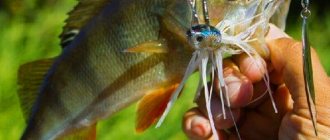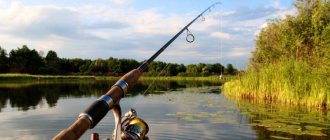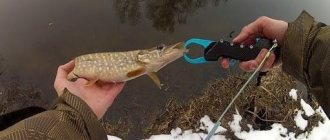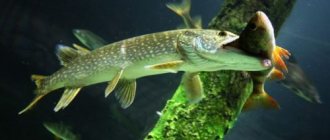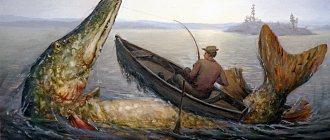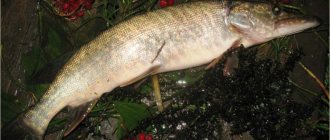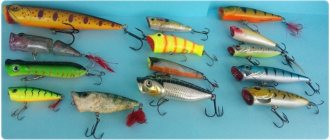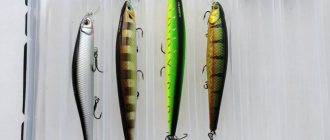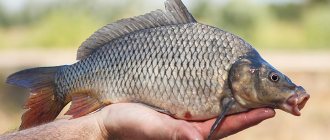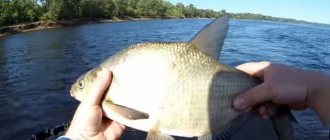Over the years, inquisitive fishermen have invented different types of baits and developed various recipes for unique baits for catching fish. At the same time, fishermen studied the behavior patterns of certain fishing objects and the influence of weather on it. As a result of such research, the modern market is filled with a large assortment of fish baits, among which a special place is given to the spinnerbait for pike.
Spinnerbait
What is a spinnerbait for fishing?
The spinnerbait is an original fishing bait that was invented 100 years ago in the USA, and appeared in our country relatively recently. The name of this bait is derived from the English words spinner - rotating spoon and bait - bait.
The spinnerbait has gained great popularity due to its high catchability and maneuverability, since these are the qualities that make it possible to use it in shallow water in standing water with dense vegetation. Predatory fish, including pike, like to ambush in such places.
The high permeability of the spinnerbait makes it more competitive in comparison with other baits made of plastic and foam rubber, and its attractive appearance and structure make it easy to lure toothy pike and ensure high bite results.
The design of a spinnerbait for pike is quite unusual - it is a thin steel rod, bent in the shape of an L or a rocker. This shape allows you to reduce snags in areas overgrown with thick grass.
Along the edges of the rod and at its bend there are loops, to one of which a fishing line is attached. A rotating petal, which plays the role of bait, and a hook, which is sometimes decorated with bright silicone plumage, are attached to the remaining loops. Sometimes 2 or more petals (spinners) and a silicone “skirt” are attached to the spinnerbait in order to better attract fish. Also, the “skirt” increases the permeability of this fishing bait through overgrown areas of the reservoir.
How to make your own bait
Having understood the principle of operation of a spinnerbait and the algorithm for selecting the elements that make up its design, you can begin making your own bait. To carry out the work, you will need to stock up on millimeter-thick steel hard wire, a powerful single hook with a long shank, silicone slugs or an elastic model, from which you can subsequently cut pieces of material covering the hook tip, a lead blank, metal for making a petal no more than 3 mm thick and beads, which will act as limiters and buffers. The tools you should have are pliers, metal scissors, as well as equipment that will help you cast the lead mold needed to make the product.
The wire will serve as the basis or frame of the simulator. Using pliers, it is bent into something like the letter L, not forgetting to make a loop at the bending point for attaching the homemade product to the carabiner and cord. The next operation is to place a load on the short arm of the curved rocker, but first you should string the required amount of beads onto the wire to arrange the plumage fasteners. Having constructed a special matrix, lead is poured into the mold in such a way that the end of the rocker arm and the single hook are monolithically poured into the material and become a continuation of one straight line, connecting in the load.
Having arranged the loading, they begin to install the purchased or independently cut petal from tin. The petal is secured using a swivel in a loop made on the long arm of the rocker arm, or the connection is arranged according to the principle of the fastening element of a rotating spoon. Having secured the petal, all that remains is to mount the silicone or rubber tail and test the homemade product, adjusting the performance characteristics of the bait by fine-tuning the shape of the petal and the weight of the sinker.
Types of spinnerbaits and their features
When examining different types of spinnerbaits from different manufacturers, it becomes clear that almost all of them are the same size. This is explained by the fact that the efficiency and excellent qualities of this bait allow you to not change anything in its shape and dimensions, and it works great when catching fish of different sizes.
Photo: Spinnerbait
Nevertheless, spinnerbaits can differ in the shape and number of petals, in the design of the rocker arm, in the type of head, as well as in the material and color of the “skirt”:
- Most fishermen use classic spinnerbaits with different blade shapes, among which “French”, “Willow Leaf”, “Colorado” and others are especially notable.
- There are also variants of spinnerbaits in which the petal is attached with a fastener, and there are models with a rigid fixation of the hook on the rod.
- Many spinnerbaits differ from each other in design elements, for example they come with 2 or 3 blades, which can be arranged in different sequences and be of different sizes.
- Some models, “buzz baits,” are equipped with a kind of “propeller” that allows the bait to be at the surface of the water and create a slight noise that attracts predatory fish.
Buzz-bait
- Spinnerbaits can be distinguished from each other by their weight heads, which can vary in weight and shape. The heads come in the shape of a fish, boat, ski and others; the main material for their manufacture is lead.
Micro spinnerbaits
These are small baits with small petals, which are usually used by small fish, usually their weight does not exceed 3.5 grams. Despite their small size, micro spinnerbaits (or mini spinnerbaits) are equipped with strong wire, fly well and can be used with any type of fishing.
Top 5 best spinnerbaits for fishing (rating)
- Terminator Titanium Twin Spin
. This spinnerbait is equipped with two wide Oklahoma blades, curved towards the bottom. Thanks to this feature, the bait demonstrates an original game during retrieves. The bait has a sharp hook and a fluffy silicone skirt. This model is released in two weight categories: 20 and 15 grams.
- Booyah Pond Magic Real Craw
. Successful, in the opinion of many anglers, combination of Colorado petals and Willow leaf provides good performance of the presented bait. The spinnerbait has a bright fiery hue that attracts predators during retrieves. It is equipped with sharp Mustad hooks and a 60-thread silicone skirt. The bait showed the best results on uniform and jerky retrieves.
- Northland Reed-Runner Magnum
. This model has two “Willow Leaf” petals. “Honeycombs” are embossed on the surface of the golden-colored petals. Two hooks are hidden under a voluminous silicone skirt. Thanks to this design and color design, the bait is effective when catching active fish.
- MegaStrike StrikeBack
. The trick of this bait is that it has a head that rotates. This ensures good bites. Willow Leaf and Colorado blades are attached to the spinnerbait.
- Johnson Beetle Spin 'R Bait
. A well-known spinnerbait, with the help of which it is easier for beginners to master the nuances of fishing with such baits. It is equipped with one petal - “Colorado” or “Willow Leaf”. The spinnerbait is equipped with a soft skirt and three beads. These elements provide vibrant animation and engaging gameplay.
Where and when to use
This bait is associated with fishing in areas that are saturated with algae and snags, because these are the places that attract predators. Although in places covered with mud, not a single hook-free bait will help.
It is best to use spinnerbaits in small open reservoirs overgrown with grass, reeds or water lilies - those places where pike most often hunt small fish, attacking them from the thickets.
Trophy pike caught with a spinning rod on a spinnerbait
Spring, summer, autumn
At times it happens that the pike even kicks the prey upward itself. Such habits are typical for pike in the summer. Many fishermen note that pike are more willing to use a spinnerbait when the grass in the pond has finished growing.
In spring, the spinnerbait begins to work only in May, since it is at this time that the water warms up and the pike becomes active.
In the fall, just before the freeze-up, there are a lot of pike in the reservoirs, but they are not so easy to catch with bait. Experienced fishermen sail a boat into the thickets and drive the pike into a clear space by striking the water with oars.
How to catch pike with a spinnerbait
When it comes to pike, a spinnerbait with 2 silver petals and a white “skirt” is most often used to catch it. This bait is suitable for active pike; if it is sluggish and passive, then it is easier to catch it with a spinnerbait with one blade.
The most effective fishing for pike with a spinnerbait looks like this: you need to carefully wind the braid onto the reel, gently shaking the tip of the rod. With such movements, the “skirt” will make contractions like the tentacles of an octopus, and the petals will rotate alternately, which will certainly attract the pike, and it will rush to the bait without hesitation.
Photo: Spinnerbait
Technique for retrieving a spinnerbait
The spinnerbait allows the angler to use various retrieve techniques. The following types are distinguished:
- Uniform retrieving is the simplest fishing method, in which its speed can be medium or minimal. This method is suitable for fishing from boats or steep banks.
- Step retrieving is a technique that involves touching the bottom when the bait falls. During reeling, the bait rises above the bottom, producing intense rotational movements.
- Shaking is the performance of sharp and impetuous movements with a fishing rod while reeling in the fishing line.
- Stop and Go wiring is in many ways similar to step animation, but is performed without touching the bottom.
When and where is a spinnerbait relevant?
Fishing for pike with a spinnerbait is successful in the summer, when areas of reservoirs promising for pike are covered with surface aquatic vegetation, which prevents comfortable fishing with other types of bait. As a rule, this non-hooking device is used in shallow backwaters, toad ponds and near the boundaries of reed walls. Spinnerbaits are also suitable for fishing snag zones in shallow waters, as well as in places near trees that have fallen into the water, where predators are highly likely to set up constant summer ambushes.
This type of bait cannot be called a universal tool, since the presence of currents and a depth of over two meters significantly worsens the performance of the bait. And the toothy one itself reluctantly reacts to the overall shape of the simulator in cold water, preferring silicones, wobblers and all kinds of spinners that are more dynamic in movement and speed of movement. Consequently, the capabilities of the bait are limited by both the place and time of fishing, which the fisherman should take into account when planning a fishing strategy with such a fishing tool in his arsenal. A wide color spectrum of plumage and petals, which determine the main color of the simulator, is selected under fishing conditions by analogy with the choice of a wobbler or spinner. In bright and sunny weather, they prefer dark color intonations, and in cloudy and gloomy weather, they use bright and eye-catching unnatural colors.
Spinnerbait for pike, which one is better?
The most popular lures for pike are spinnerbaits of white, silver, black and red colors, since they work well in both clear and muddy water.
Specimens with a copper petal and a yellow silicone “skirt” are ideal for catching pike in clear water.
Pike attacks spinnerbait
In order to lure pike in places where grass and algae accumulate, as well as in muddy water, you can choose models with nickel-plated blades or fluorescent spinnerbaits.
For fishing at depth, heavy spinnerbaits are most often used, which sink quickly and do not create resistance in the water. When choosing a spinnerbait by weight, you should take into account the number of petals, their shape, as well as the depth of the reservoir and wiring technique. Light baits are more often used at the surface of the water, while heavy ones are good for fishing on the bottom.
Tips for making your own spinnerbait
When assembling bait for pike perch with your own hands, you should never save money on the swivel, because the number of fish caught is very dependent on the free movement of the blade. It is necessary for it to start moving at the slowest speed. The petal should also work in free fall, when the spinnerbait for pike perch is lowered into the water. In order to achieve such a movement, it is necessary to use a swivel on bearings .
The spinner has a wire base. There is a petal at one end, and a special head is securely attached to the second. The hook and weight are covered with a skirt, which, in addition to luring predators, serves to protect against various snags. Additionally, large pieces of silicone can give the spinner an uneven and unique movement that causes predatory fish to chase the bait. The first bite happens very quickly.
To make a spinner with your own hands, you can use the following materials:
- stainless steel wire;
- hooks with a rather long shank;
- lead sinker;
- stainless metal petals;
- various beads for baiting predatory fish;
- swivel and two winding rings;
- To assemble the skirt, you should use regular elastic bands.
To assemble the spinnerbait you will need the following tools:
- round nose pliers;
- pliers;
- special mold for casting cargo.
How to properly attach a spinnerbait to a fishing line on a pike, installation
In order to catch pike in the fronds from the shore, you will need a rod at least 2.7 meters long, and if you fish from a boat, you can get by with a 2-meter spinning rod. A reel with a spool capacity of 2000-3000, a fishing line with a diameter of 0.1-0.6 mm and a metal leader is attached to the spinning rod.
The bait is attached to the fishing line using a loop located on the rocker arm. The loop can be open or rolled into a ring (closed); this determines which knot to tie the fishing line to the bait with - a palomar (see photo below) or by fastening a carabiner from the main fishing line.
Knot Palomar or Palomar
Light-weight spinnerbaits do not require special gear; monofilament fishing line, a short rod and metal leaders are sufficient. Before fixing the bait, you should inspect it for defects, for example, an even slope of the arc or an acute angle for better sliding of the spinnerbait along the bottom of the reservoir.
Pike caught on a spinnerbait
Tackle for fishing with spinnerbait
To successfully fish with spinnerbaits, you will need a fairly rigid spinning rod, which will allow for proper retrieval.
On the other hand, a stick that is too stiff makes long casting difficult, so it is necessary to find a compromise solution. If you are fishing from the shore, you need a longer rod; if you are fishing from a boat, you need a shorter one. Let us remember that a spinnerbait has a large windage and cannot be cast far.
Approximate parameters when choosing a fishing rod:
- medium tuning,
- length from 2.7 to 3.5 meters
- test in 10-30 g.
There are no special requirements for the reel, the main thing in it is good reliability and a sensitive drag, the reel size is from 2500, the spool is preferably shallow. But it is better to use braided fishing line. Also, be sure to use strong leashes with a length of 13-15 cm, because most often it is the toothed pike that bites on the spinnerbait.
Leaders can be made of titanium, steel or fluorocarbon. Fluorocarbon leaders should be no thinner than 0.4mm. This will protect your line from rubbing against the sharp teeth of the pike.
Popular manufacturers, prices
Any bait that is used when fishing among algae implies a consumable material, so its price is important. Many companies producing spinnerbaits are constantly improving the design and improving the materials used to make baits, so the quality-price ratio is quite justified.
Depending on the size, number of petals, materials used in the manufacture and manufacturer, the cost of spinnerbaits varies from 200 to 1600 rubles.
- Kosadaka (Kosadaka). It is a product of the Japanese company of the same name and is a copy of the 2014 model bait, invented in the USA. The price of such a spinnerbait is 300 rubles.
- Lucky John (Lucky John). The cost of spinnerbaits of this brand ranges from 250 to 500 rubles.
- Megabass (Megabass). A Japanese fishing tackle manufacturer that occupies a leading position in the production of effective lures. Megabass brand spinnerbaits cost about 970-1050 rubles.
- Lucky Craft (Lucky Craft). A transnational company that produces and markets fishing gear in the American and Japanese markets. The company also produces spinnerbaits of various sizes and designs. The estimated cost of such baits ranges from 200 to 850 rubles per 1 piece. There are also compact copies for 80 rubles.
- Booyah (Buyah). One of the largest manufacturers of spinnerbaits, whose parent company is based in the USA. Booyah baits are presented in a fairly wide range, and their cost is 400-600 rubles.
You can also find spinnerbaits on sale from the following manufacturers: Blue Fox, Daiwa, Storm, Balzer, Strike King, Ever Green, Berkley, Grauvell, Yakima Bait, Strike Pro, Deps, Savage Gear, Smith, Z-man, C'ultiva and other. Inexpensive replicas can be bought on Aliexpress.
Types of baits
Thanks to the wide variety of spinnerbaits, the angler always has the opportunity to accurately select the bait to suit his conditions. To understand the parameters in more detail, let us highlight their distinctive characteristics.
Petal shape
This part has a variety of designs, but the main ones are “Colorado”, “Indiana” and “Willow Leaf”.
Colorado-type petals provide the bait with the maximum possible lifting effect. This behavior is possible due to the round shape, which provides the largest surface area. As a result, baits with petals of this type, unlike other models, have the ability to move along the surface. It is more advisable to use them for hunting in shallow water, in cloudy, colored water, since the bait is endowed with excellent acoustic properties. Indiana type petals have a more elongated shape than Colorado type. Their surface area is also quite good. Lures equipped with this type of petals move at greater depths compared to Colorado ones. The generation of acoustic vibrations is an order of magnitude lower. This spinnerbait works best in not very polluted water and in low light.
Petals of the “Willow Leaf” type are the narrowest among the described models. As they rotate, they create weak acoustic vibrations. Due to the high rotation speed, the intensity of their shine is observed. When retrieving, the bait acquires a long shape and sinks deeper. There is an option to use a spinnerbait with willow leaves in shallow water, but on condition that the retrieve speed is increased. The greatest effectiveness of these petals was noted when fishing in a clean, transparent reservoir.
To increase the return of the bait, you can use the following simple technique. On a standard rocker arm of the same model, try combining two completely different types of petals. For example, a spinnerbait with Colorado and Willow Leaf blades. This combination will add not only an acoustic, but also a lighting effect. The number of petals should not be more than two.
Rocker
The rocker design is the basis of each spinnerbait, ensuring normal operation and high maneuverability of the bait. One of the popular types is considered to be a regular equal-arm angle, made of rigid wire with a bending angle of 80-90 degrees. It is the two upper shoulders that make it possible to spread the petals along the plane.
Of course, the manufacturing process of such structures is very complicated, but it’s worth it to get closer to maximum snag-free performance. In some bait models, the upper arm is divided into two identical parts, connected to each other by a hinge. You can also find rocker arms with the upper arm bent downwards. There are options with open and closed ears. Stainless and titanium wire is used as material for the production of the frame.
Weight head
This element comes with a non-removable lower tier. Depending on fishing conditions, the weight of the head may vary. The weight standard is in the range of 3.5-20 g. They produce a wide variety of head shapes: imitation of the body of a fish, the bow of a boat, etc. All baits in the back of the head are equipped with peculiar bulges and teeth to securely hold the delicate skirt. Lead is used as a material for the production of heads.
Skirt
The material used for the skirt is silicone, PVC, rubber or leather. The strips may vary in width, thickness and hardness. There are no fundamental restrictions on coloring. All colors of the rainbow, as well as their combinations, will be relevant for this element. Natural materials for making skirts are also in demand: fur, wool and feathers. By the way, the skirt can be replaced with twisters and vibrating tails, which are mounted on a hook.

